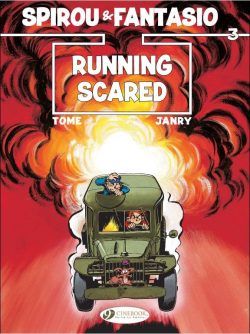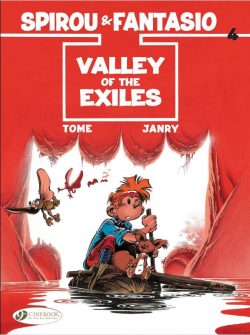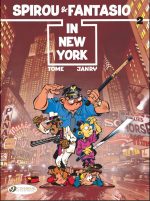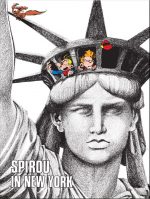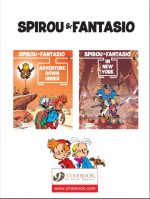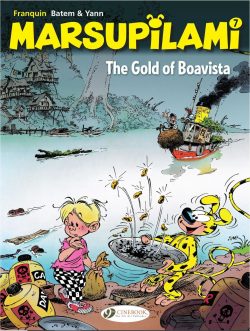
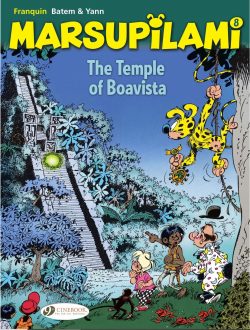
By Yann & Batem, coloured by Cerise and translated by Jerome Saincantin (Cinebook)
ISBN: 978-1-80044-069-2 (Album PB/Digital edition Gold)
ISBN: 978-1 80044-099-9 (Album PB/Digital edition Temple)
Win’s Christmas Gift Recommendation: Mad Monkeyshines with Gallic Aplomb… 9/10
One of Europe’s most popular comic stars is an eccentrically irascible, loyally unpredictable, super-strong, rubber-limbed ball of explosive energy with a seemingly infinite elastic tail. The frantic, frenetic Marsupilami is a wonder of nature and icon of European entertainment originally spun-off from another immortal comedy adventure strip…
When Andre Franquin began crafting eponymous keystone strip Spirou for eponymous flagship publication Le Journal de Spirou, he quickly abandoned the previous format of short complete gags to pioneer longer adventure serials, and began introducing a wide and engaging cast of new characters.
For 1952’s Spirou et les heritiers, he then devised a beguilingly boisterous South American critter and tossed him like an elastic-arsed grenade into the mix. Thereafter – until resigning in 1969 – Franquin constantly added the bombastic little beast to Spirou’s increasingly incredible escapades…
Marsupilami popped up constantly: a phenomenally popular wonder animal who inevitably grew into a solo star of screen, toy store, console games and albums all his own. In 1955 a contractual spat with Dupuis saw Franquin sign up with publishing rivals Casterman for Le Journal de Tintin: collaborating with René Goscinny and old pal Peyo whilst creating raucous gag strip Modeste et Pompon.
Franquin and Dupuis patched things up within days, and he went back to Le Journal de Spirou. In 1957, he co-created Gaston Lagaffe, but was still legally obliged to carry on his Tintin work too. From 1959, writer Greg and background artist Jidéhem assisted, but over the next decade Franquin reached his Spirou limit. In 1969 he quit for good, taking his mystic yellow monkey with him…
Plagued by bouts of depression, Franquin passed away on January 5th 1997, but his legacy remains: a vast body of work that reshaped European comics. Moreover, having learned his lessons about publishers, Franquin retained all rights to Marsupilami and in the late 1980’s began publishing his own adventures of the rambunctious miracle-worker.
He recruited old comrade Greg as scripter and invited commercial artist/illustrator Luc Collin (AKA Batem) to collaborate on – and later monopolise – art duties for the new adventures. In recent years, the commercial world triumphed again and – since 2016 – the universes of Marsupilami and Spirou have reconnected, allowing the old firm to participate in shared exploits of a world created and populated by Franquin.
Graced with a talent for mischief, the Marsupilami is a deviously ingenious anthropoid inhabiting the rainforests of Palombia. One of the rarest animals on Earth, it speaks a language uniquely its own and has a reputation for making trouble and sparking chaos. The species is rare and is fanatically dedicated to its young. Sometimes that takes the form of “tough love”. This behaviour frequently extends to any humans it encounters and “adopts”…
The first of two books telling one tale, L’or de Boavista was released in October 1992. The seventh of 33 solo albums, it was followed a year later by concluding volume Le Temple de Boavista, combining into an edgily gripping comedy drama with much dark and scary social activism underpinning the usual hairy hijinks.
It opens in Palombian capital Chiquito, where children are going missing. No one cared when it was orphans and homeless urchins, but it’s quite different when Donald Maxwell-Trent plays truant and is abducted off the street. He’s spoiled, rich and the son of the US Ambassador…
Tragically, that means nothing to the ruthless thugs who need a constant supply of kids his size and age to work at an illegal, highly polluting goldmine in the jungle upriver. The toxic mess and mercury-made mire these Garimpeiros are creating has incensed and outraged the Marsupilami who now deems them his worst enemies ever…
After another of the yellow terror’s night attacks, overseer Solaria – a slightly older boy with an agenda of his own – helps Donald, now cruelly called “Gordito” by his malnourished comrades, to escape into the green hell. The older boy is only interested in freedom, wealth and returning to the undiscovered tribe he was stolen from, but from his cough may have waited too long to make his break…
Soon brutal gang boss Ingo is in hot pursuit, but his party’s progress is severely hampered by the stalking Marsu – whenever the golden beast isn’t clandestinely helping the fugitives. The furious furry (called by Polombians “El diablo”, and “La catestrofe amarilla”) is then instrumental in linking up the lads with an acceptable resident human…
Transplanted animal trainer Noah keeps his menagerie of friends on a river boat. Appalled by what Solario tells him, Noah resolves to stop the mining but that confrontation does not work out as planned and soon they are all fleeing for their lives up the dreaded Rio Boavista into lethal, legend-drenched “Spatoolah Territory” with dozens of killers on their collective tails…
To Be Concluded…
The dark drama heads into even wilder regions with The Temple of Boavista as relentless pursuit drives our heroes ever deeper into unexplored locales of the mighty tributary. Thankfully the hidden people they meet are mostly friendly, but their heightened state of fear is not ended for long. That night the jungle reverberates with horrific laughter emanating from a gargantuan edifice almost reclaimed by centuries of encroaching trees and vines…
The building is an ancient Zygomaztec temple and in its lee are some very nasty tomb robbers. Zoltan and Zorrino plan on stealing Noah’s floating zoo to carry their latest haul, but haven’t reckoned on the alliance of kids and tribal people, nor whatever is making the dire noises wracking the night with sinister sounds.
… And that’s before Ingo’s Garimpeiros and utterly fed up and furious Marsupilami get involved, or morose millionaire Harold “Buster” Stonelove and his safari guide Rhode Island Smith show up. These “ugly Americans” are looking for the secret of laughter and believe the raucous ruins can supply their answer, when they should be watching the yellow critter with the elastic tail and bad attitude…
As all the competing factions calamitously converge on the temple interior, a remarkable answer to the mirth mystery emerges and in a storm of giggling terror everybody gets jut what they deserve…
These eccentric exploits of the garrulous golden monkey are moodily macabre, furiously funny and pithily pertinent, offering engagingly riotous romps and devastating debacles for wide-eyed kids of every age all over the world. Fancy channelling your inner El Diablo and joining in the fun? It all starts with Hoobee, Hoobah Hoobah…
Marsupilami: The Gold of Boavista Original edition © Dupuis 1992, by Batem & Yann
Marsupilami: Temple of Boavista Original edition © Dupuis, Dargaud-Lombard s.a. 1993, by Batem & Yann, Franquin. All rights reserved. English translations © 2022 Cinebook Ltd.
© Marsu Productions 1992. All rights reserved. English translation © 2022 Cinebook Ltd.

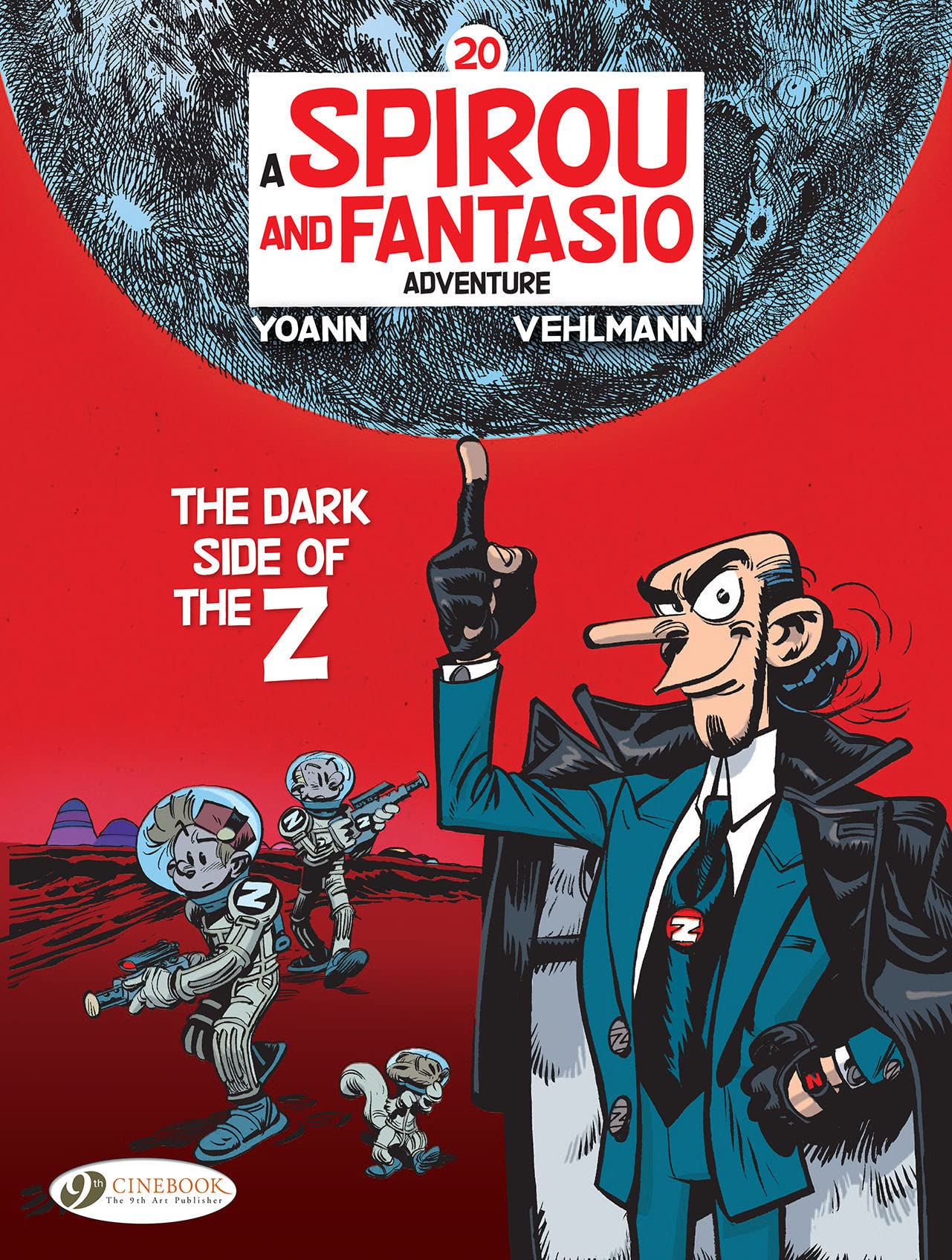

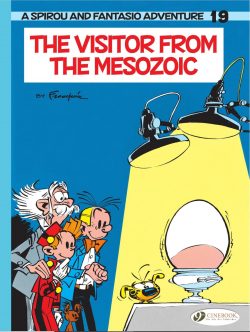
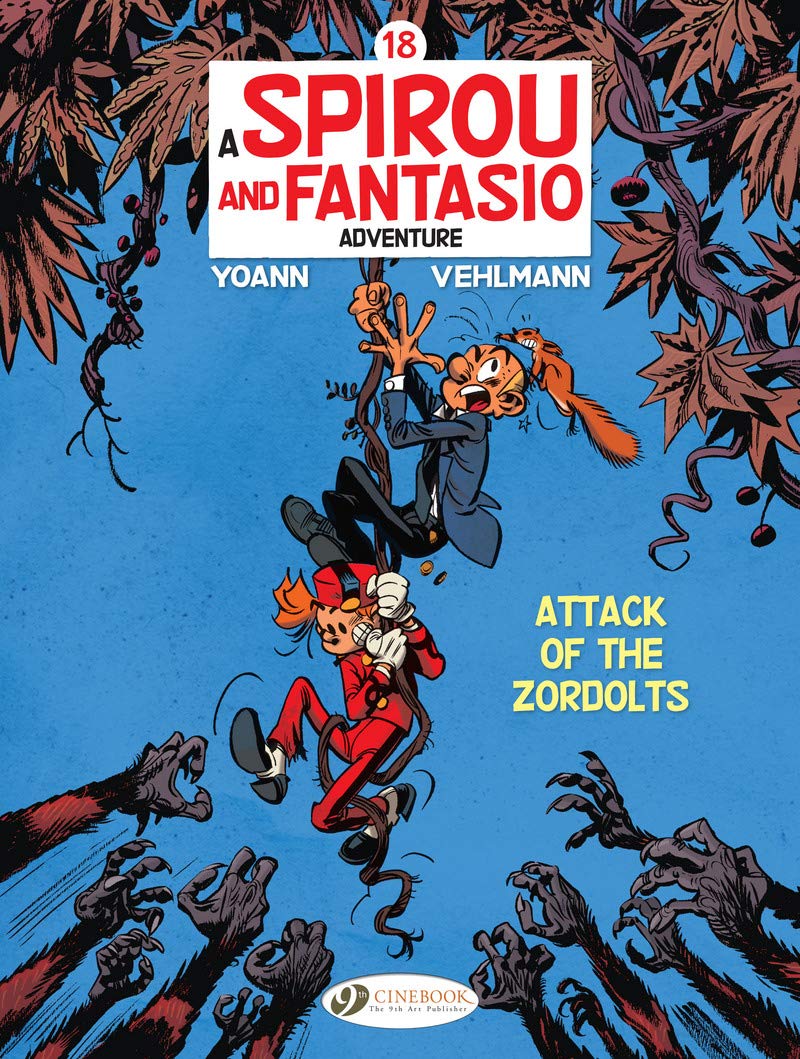
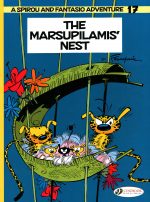

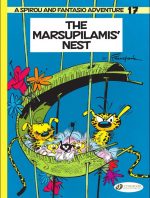
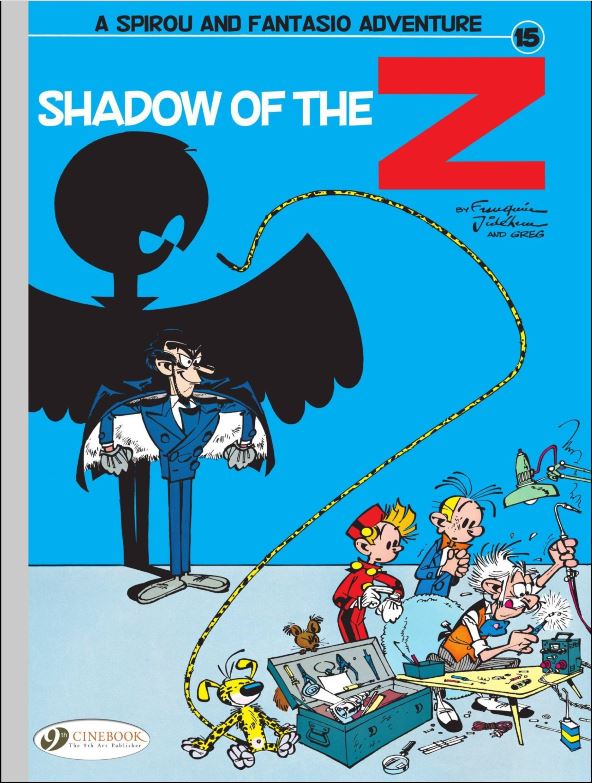
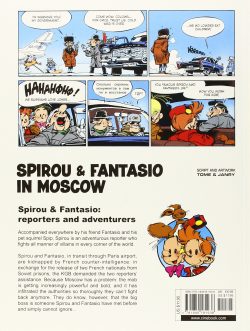
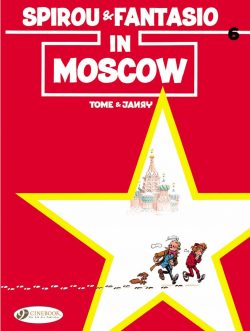
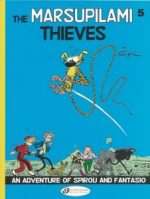

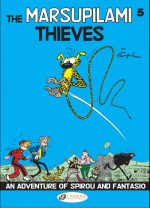 y André Franquin, translated by Jerome Saincantin (Cinebook)
y André Franquin, translated by Jerome Saincantin (Cinebook)